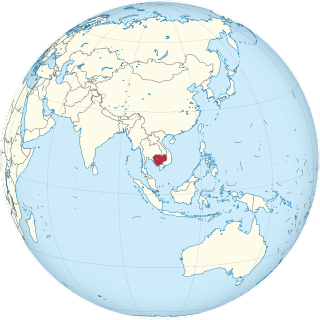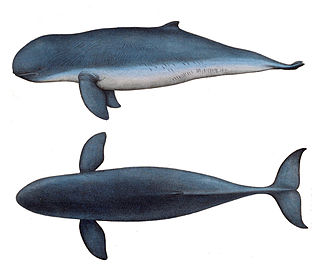
Cambodia is a country in mainland Southeast Asia, border Thailand, Laos, Vietnam, the Gulf of Thailand and covers a total area of 181,035 km2 (69,898 sq mi). The country is situated in its entirety inside the tropical Indomalayan realm and the Indochina Time zone (ICT).

The Mekong or Mekong River is a trans-boundary river in East Asia and Southeast Asia. It is the world's twelfth longest river and the sixth longest in Asia. Its estimated length is 4,909 km (3,050 mi), and it drains an area of 795,000 km2 (307,000 sq mi), discharging 475 km3 (114 cu mi) of water annually. From the Tibetan Plateau the river runs through China, Myanmar, Laos, Thailand, Cambodia, and Vietnam. The extreme seasonal variations in flow and the presence of rapids and waterfalls in the Mekong make navigation difficult. Even so, the river is a major trade route between western China and Southeast Asia.

Tonlé Sap is a seasonally inundated freshwater lake, Tonlé Sap Lake, and an attached river, the 120 km (75 mi) long Tonlé Sap River, that connects the lake to the Mekong River. They form the central part of a complex hydrological system, in the 12,876 km2 (4,971 sq mi) Cambodian floodplain covered with a mosaic of natural and agricultural habitats that the Mekong replenishes with water and sediments annually. The central plain formation is the result of millions of years of Mekong alluvial deposition and discharge. From a geological perspective, the Tonlé Sap Lake and Tonlé Sap River are a current freeze-frame representation of the slowly but continuously shifting lower Mekong basin. Annual fluctuation of the Mekong's water volume, supplemented by the Asian monsoon regime, causes a unique flow reversal of the Tonlé Sap River. The largest freshwater lake in Southeast Asia, it contains an exceptional large variety of interconnected eco-regions with a high degree of biodiversity and is therefore a biodiversity hotspot. It was designated a UNESCO biosphere reserve in 1997.

The Irrawaddy dolphin is a euryhaline species of oceanic dolphin found in discontinuous subpopulations near sea coasts and in estuaries and rivers in parts of the Bay of Bengal and Southeast Asia. It closely resembles the Australian snubfin dolphin and was not described as a separate species until 2005. It has a slate blue to a slate gray color and are a part of genus Orcaella which is also known as snubfin dolphins. Although found in much of the riverine and marine zones of South and Southeast Asia, the only concentrated lagoon populations are found in Chilika Lake in Odisha, India and Songkhla Lake in southern Thailand.

The snubfin dolphins (Orcaella) are a genus of cetaceans containing two members: the Irrawaddy dolphin and the Australian snubfin dolphin. The genus was long believed to be monotypic with the only species being the Irrawaddy dolphin; however, in 2005, supposed Irrawaddy dolphin populations inhabiting the Australian/New Guinean regions were found to be significantly different and were declared a separate new species named the Australian snubfin dolphin.

The ticto barb or twospot barb is a species of subtropical freshwater fish belonging to the family Cyprinidae. It is a native of the upper Mekong, Salwen, Irrawaddy, Meklong and upper Charo Phraya basins in the countries of Nepal, India, Pakistan, Myanmar, Bangladesh, Thailand, and Sri Lanka. It has frequently been confused with the Odessa barb in the aquarium trade, but in that species the male is reddish-orange.

The iridescent shark,iridescent shark catfish or tra catfish is a species of shark catfish native to the rivers of Southeast Asia. Despite its name, it is not a shark. It is found in the Mekong basin as well as the Chao Phraya River, and is heavily cultivated for food there.

The Mekong giant catfish, is a large, critically endangered species of catfish in the shark catfish family (Pangasiidae), native to the Mekong basin in Southeast Asia and adjacent China. It is considered critically endangered due to accelerating habitat loss.

Barbodes binotatus, commonly known as the spotted barb or common barb, is a tropical species of cyprinid fish native to Southeast Asia. It has also become established as an exotic species in Palau and Singapore.

Hemibagrus wyckioides, the Asian redtail catfish, is a species of catfish of the family Bagridae.
Hemibagrus wyckii is a species of catfish of the family Bagridae. It is occasionally called the crystal-eyed catfish.

Hemibagrus is a genus of catfishes of the family Bagridae.

The Java barb, more commonly known as silver barb in aquaculture, is a species of ray-finned fish in the genus Barbonymus.
Hemibagrus punctatus is a fish species first described by Jerdon in 1849. Hemibagrus punctatus is a member of the genus Hemibagrus and the family Bagridae. It is endemic to east-flowing rivers in the Western Ghats of India. Of these, the species is likely only found in the Kaveri River; records from the Krishna River may actually be of H. maydelli. However, one record from the west-flowing Bharatappuzha River has been tentatively assigned to this species. The last record of this species was in 1998, and it may have experienced a population decline of nearly 100%; thus, IUCN categorizes the species as critically endangered. It is threatened by habitat degradation by excess siltation, excess fishing, and dam construction. However, based on several specimens caught by fishermen between 2011-2012 that likely belong to this species, as well as testimonies from local fishers, moderate populations of this species may still be extant in the region.

Hemibagrus nemurus is a species of catfishes of the genus Hemibagrus in the family Bagridae. After a major review by Ng and Kottelat (2013), its distribution is believed to be confined (endemic) to Java. It is found in Sumatra in the Bukit Tigapuluh National Park in 2016, too.

The elephant ear gourami is a large species of gourami native to the Mekong in Thailand, Laos, and Cambodia.
Pristolepis fasciatus, commonly known as the Malayan leaffish, is a fish in the family Pristolepididae. It lives in the Mekong and Chao Phraya basins in Thailand, Cambodia, Vietnam, Myanmar, the Malay Peninsula, Sumatra, and Borneo, possibly also in southern India and China.
Mystus albolineatus is a species of catfish endemic to Cambodia, Thailand and Vietnam, known from Chao Phraya River, Bang Pakong River, Mekong River and Tonlé Sap. It is found in flowing and standing waters especially near submerged woody vegetation; it feeds on zooplankton, fishes and insect larvae such as chironomidae. It spawns before or during the rainy season and the young were first caught in July and August. It occurs in both the market and aquarium trade and is fished with seines, gillnets and traps. It is not considered threatened thus listed Least Concern, however, further research about this fish is needed.
Hemibagrus divaricatus is a species of bagrid catfish found in the Perak River drainage in the western Peninsula of Malaysia. This species reaches a length of 30.8 cm (12.1 in).
Hemibagrus semotus is a species of bagrid catfish found in the Padas River drainage and the shorter coastal rivers which drain the west face of the Crocker Range in northern Borneo, Sabah, Malaysia. This species reaches a length of 19.9 cm (7.8 in).














